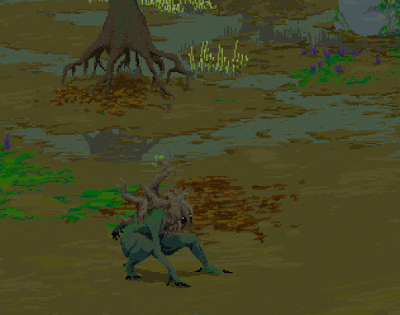 |
| This runestone serves as the main menu (options not visible) and part of the opening cinematic. |
 |
| Many missing tiles, and the ! is placeholder. (Also a lousy screenshot.) |
 |
| Here are just a few of the missing tiles, and sprites that replace the ! icons. |
The basic gist of the game is that the player is one of the eponymous “Fallen Gods,” who must win his way back to the Cloudlands — our Asgard — by hook or crook. I don’t want to spoil too much at this point, but basically it is a bleak game that blends Norse mythology and Icelandic folklore (and European folklore more generally) with a rather bleak worldview that fell upon me when reading a series of books about the aftermath of various revolutions (Russian, French, Bolivarian, and anti-colonial wars of liberation in Africa). The current pantheon of Fallen Gods successfully overthrew the indifferent, and even cruel, primordial gods who ruled before them (a blend of titans and animistic prehistorical gods). Despite this signal and perhaps noble victory, the new gods, led by Orm the Trickster, have proven fairly inept as divinities and catastrophe has befallen the world: political, ecological (I was also reading, among other things, The Earth Without Us and The Sixth Extinction), and spiritual.
Anyway, the “hero” — more anti-hero, or let us just say, player character — has a fixed number of days to make his way back to the Cloudlands, lest he become mortal forever. The game plays out through three systems: the world map (depicted above), events (which are still coming together from an interface standpoint), and combat (which is still in the mockup stage).
Here’s a look at some of the combat art:
 |
| A bogwight in its native environment. |
 |
| A troll. In theory, at least, the far background will be contextual to the map. |
It’s a shame that I don’t have a great pic of the warband facing off against some of these foes. I can only say that the artist — Daniel Miller — is simply amazing. These are true pixel art, drawn dot by dot, each frame drawn from scratch.
Finally, here are a few examples of events:
 |
| So this is a look at how they actually work: text with options. |
 |
| A draug in “The Dead Hand.” (How the images look as standalones.) |
 |
| “The Lights of Skyhold” |
 |
| Some still worship the old gods. |
 |
| The corpse of Karringar, one of the defeated Firstborn. |



